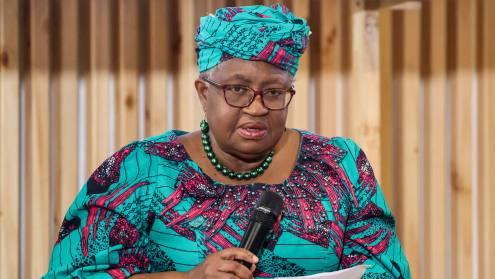As “a decisive decade for climate action,” the agenda for the 28th annual meetings of the Conference of the Parties (COP) in Dubai is as jam-packed as ever, with priorities such as individual countries’ progress on meeting their Paris Climate Agreement commitments, accelerating the green transition and agreeing on a goal for climate finance to help fund developing countries.
But for Huw van Steenis, vice-chair of Oliver Wyman, who led the Future of Finance report for former Bank of England governor Mark Carney and is a member of the climate advisory board of the Norwegian sovereign wealth fund, it is the debates and activities that take place outside the formal negotiations at COP that are the area to focus on.
This year’s COP, he observes, is taking place against a backdrop where energy security issues resulting from the war in Ukraine mean policy-makers and the private sector will be trading off energy security, energy affordability and the environment, which has important implications for finance. He also expects to see much progress on the next generation of portfolios and metrics that investors, banks and asset owners will use to navigate decarbonisation and climate risk.
“In light of the changing macro environment, cost of capital, the Ukrainian war, energy security, and quite frankly, the pace of policy-making, what does that mean for the ability to honour these targets or make practical steps forward?” he asks.
Mr van Steenis says climate is now a much more complicated environment for financial professionals to navigate. “Today, the nature of the risk is more acute, but complex,” he says. “Legal risks have shifted up the pecking order. So too, some physical manifestations of climate change have come much sooner than some had expected.” But on the other hand, energy security means that some governments are moving at very different speeds. Also, policy mis-steps, such as Germany’s energy decisions, mean that some countries are even going backward, he says.
Having moderated a Net Zero Banking Alliance gathering in New York around NY Climate Week, his main takeaway from that event is that there is a genuine desire among financial services firms to continue to navigate thoughtfully the transition to a lower-carbon economy. “But what they’re finding is they need to get more into the value chains of each industry, given the huge complexity and interdependencies. So, what does this mean in agriculture or transportation? What is the glide path in different sectors and geographies?” he asks.
Banks and investors seek the next generation of climate metrics and targets
Many of the conversations Oliver Wyman has with banks, insurers and investors look at the next generation of targets, metrics and data to help make smarter investment decisions. Like all progress, the first iteration is never where you end up, says Mr van Steenis, adding that there is much work being done to re-assess what is “decision-useful” (a term he adopted from working with Mr Carney), and reflect the huge changes in political economy, policies, interest rates and energy security.
“Investors remain keen to weave risks and opportunities such as energy transition and energy security into their portfolios,” he says. “We’re seeing a flurry of new fund launches far more focused on the complex and bumpy path to a more decarbonised world, and far less on an overly simplistic interpretation of environmental, social and governance (ESG) factors. Once again investors have learned the hard way never to invest by acronym.”
One area where Mr van Steenis expects to see more discussion at COP28 is around emission reduction targets for hard-to-abate sectors like oil and gas. He thinks it likely there may be significant progress towards near-zero methane targets by 2030. While the first generation of targets were set around absolute emission reduction, Mr van Steenis says there is now much more focus on measures that are about reducing emissions intensity, both for heavy emitters and for investors.
“So, how can a company become cleaner, better, more efficient? With the high energy prices we’ve had there is obviously a focus on trying to become ever more efficient,” he says. “And that’s in the context of energy security as well. But it’s about emissions intensity. How do we finance emissions reduction? If you build a new wind farm, it’s very emissions-intensive to start because you’ve got to smelt the iron and transport them.
“I think there’s a much more nuanced discussion about what are the right tools to steer portfolios. That’s something I suspect will be debated at the fringe events at COP because getting the right tools is critical for the future.”
He says more investors in public markets are questioning the “paper decarbonisation” of many funds in the ESG space: simply avoiding higher emitters rather than engaging in real-world efforts on reducing carbon does nothing. “We need to focus on what is useful at the company level. How is it tracking and how are the plans versus peers in its sector, or across its industry value chain? If its fourth quartile, what does that mean for value?” There is a huge increase in demand for underlying data, he says. “Investors and banks also want more forward-looking metrics than rear-view mirror.”
Climate is a whole-economy transition
When it comes to accelerating decarbonisation, Mr van Steenis says there could be a series of ‘clubs’ formed within the private sector at COP28 this year that work together to use new technologies like hydrogen or ammonia. “You may see several large groups coming together,” he explains, “and say, we’re going to put some money to work in a private sector fund to accelerate hydrogen or ammonia.”
There may also be what he calls “worthy plumbing measures” emerging from private sector negotiations at COP28, which help investors or banks better interrogate the business plans of companies they finance. “I wouldn’t say a global common approach because we’re never going to get that, but you know, some similarity between how we disclose corporate plans and the measures which are important,” he adds. “I also think there’ll be some commitment towards making more progress on standards for the voluntary carbon markets, which remain pretty contentious, even if it’s a commitment to make progress by the next COP.”
These standards could be around how you should use voluntary carbon markets, he says. “What’s the quality? What’s the exchange ratio between a Scandinavian forest versus a Indonesian mangrove versus seagrass in the Bahamas. It’s an incredibly complicated space, without a common standard, but what many hope for is to have some common principles, then each jurisdiction which sets laws, policy and standards, can then try to fashion something which sort-of works.”
Finance has already done a lot, says Mr van Steenis. “It is now time for policy-makers to determine the pace each and every country wants to run on.” He points to the role of ‘catalytic’ policies such as the Inflation Reduction Act (IRA) in the US or the EU’s Green Deal.
Preliminary estimates suggest that the IRA is capitalising two to three times more investment than the original Congressional Budget Office forecasts. “These are not seasoned numbers but it looks like it is a very powerful tool for catalysing investment,” says Mr van Steenis. “Now we can debate whether this is a little bit of front-loading, people going in early and where the scale of this might be, but if that holds it’s likely to be one of the single most successful fiscal policies in US history.”
Thinking about the catalytic effect of public policy support — not just money, but also the investments in hard research in the universities — is just as important, he adds. “How can we work together on one of the dominant economic challenges of our time? There is a huge role for private capital to play here across the capital structure. Many more private equity firms and private credit firms are thinking, what is their role in the different slices of the capital structure? That speaks to the maturing of climate finance, understanding this as a whole economy transition, and different sectors and different companies require different kinds of finance.”
Read other interviews from the COP28 preview series:








